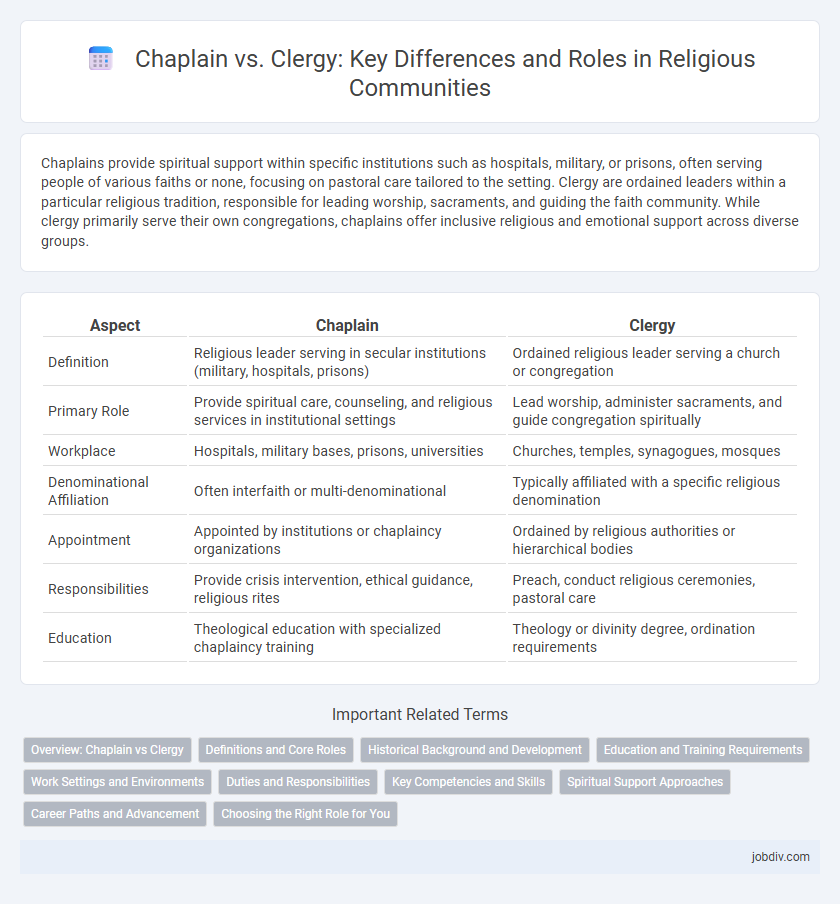Chaplains provide spiritual support within specific institutions such as hospitals, military, or prisons, often serving people of various faiths or none, focusing on pastoral care tailored to the setting. Clergy are ordained leaders within a particular religious tradition, responsible for leading worship, sacraments, and guiding the faith community. While clergy primarily serve their own congregations, chaplains offer inclusive religious and emotional support across diverse groups.
Table of Comparison
| Aspect | Chaplain | Clergy |
|---|---|---|
| Definition | Religious leader serving in secular institutions (military, hospitals, prisons) | Ordained religious leader serving a church or congregation |
| Primary Role | Provide spiritual care, counseling, and religious services in institutional settings | Lead worship, administer sacraments, and guide congregation spiritually |
| Workplace | Hospitals, military bases, prisons, universities | Churches, temples, synagogues, mosques |
| Denominational Affiliation | Often interfaith or multi-denominational | Typically affiliated with a specific religious denomination |
| Appointment | Appointed by institutions or chaplaincy organizations | Ordained by religious authorities or hierarchical bodies |
| Responsibilities | Provide crisis intervention, ethical guidance, religious rites | Preach, conduct religious ceremonies, pastoral care |
| Education | Theological education with specialized chaplaincy training | Theology or divinity degree, ordination requirements |
Overview: Chaplain vs Clergy
Chaplains serve in specific institutions such as hospitals, military, or prisons, providing spiritual support to diverse populations regardless of religious affiliation. Clergy typically lead religious congregations, performing sacraments, rites, and pastoral duties within a particular faith tradition. Both roles focus on spiritual care, but chaplains have a broader, more interfaith scope compared to clergy's denominational leadership.
Definitions and Core Roles
A chaplain is a religious representative who provides spiritual support and guidance within secular institutions such as hospitals, military units, prisons, or universities, often serving people of diverse faiths. Clergy refers to ordained religious leaders, such as priests, ministers, or pastors, responsible for conducting worship services, administering sacraments, and leading congregations within a specific faith community. The core role of chaplains centers on offering interfaith pastoral care and counseling in institutional settings, while clergy focus primarily on religious leadership and doctrinal teachings within their own faith tradition.
Historical Background and Development
Chaplains originated in military and institutional contexts, providing spiritual care to soldiers and hospital patients, evolving from early Christian military chapels in the Middle Ages. Clergy, rooted in ecclesiastical traditions, have served as ordained ministers leading congregations, with roles formalized through church councils and canon law since antiquity. The historical development of chaplaincy reflects a specialized, non-parochial ministry distinct from the broader religious authority and sacramental duties of clergy.
Education and Training Requirements
Chaplains typically undergo specialized training that includes clinical pastoral education (CPE) to provide spiritual support in institutional settings such as hospitals, military, or prisons. Clergy are generally required to complete formal theological education, often a seminary degree like a Master of Divinity, along with ordination from their religious denomination. While both roles demand deep religious knowledge, chaplains emphasize practical pastoral care skills and interfaith competencies, whereas clergy focus on doctrinal instruction and congregational leadership.
Work Settings and Environments
Chaplains typically work in institutional settings such as hospitals, military bases, prisons, and universities, providing spiritual support tailored to diverse populations. Clergy primarily serve within religious congregations, leading worship services, performing sacraments, and engaging in pastoral care within churches, synagogues, or mosques. Both roles demand adaptability, but chaplains often operate in secular or multi-faith environments requiring interfaith sensitivity and crisis management skills.
Duties and Responsibilities
Chaplains provide spiritual care and emotional support primarily within institutional settings such as hospitals, military, prisons, or universities, addressing the unique needs of diverse populations. Clergy members lead congregations by performing religious rituals, preaching, administering sacraments, and offering pastoral counseling within a specific faith community. While both roles involve spiritual leadership, chaplains emphasize interfaith ministry and crisis intervention, whereas clergy focus on faith formation and community worship.
Key Competencies and Skills
Chaplains require strong interfaith communication skills, crisis intervention expertise, and the ability to provide emotional support in diverse, often secular settings. Clergy members typically possess deep theological knowledge, pastoral counseling abilities, and leadership skills within their specific religious tradition. Both roles demand empathy, spiritual guidance, and the capacity to facilitate rituals, but chaplains emphasize adaptability across varied faiths while clergy focus on ministering within a defined religious community.
Spiritual Support Approaches
Chaplains provide spiritual support that is inclusive and adaptable, serving individuals across diverse faiths and secular backgrounds often in institutional settings like hospitals, prisons, or the military. Clergy typically offer guidance rooted in specific religious doctrines and traditions, focusing on the spiritual needs of members within their own faith community. Both emphasize compassionate care but differ in context and scope, with chaplains specialized in interfaith ministry and crisis intervention.
Career Paths and Advancement
Chaplains often serve specialized roles within institutions like hospitals, military, or prisons, requiring adaptability to diverse environments and the ability to provide spiritual care in non-traditional settings. Clergy typically advance within established religious organizations, focusing on congregational leadership, pastoral duties, and denominational responsibilities that may include preaching, counseling, and administrative roles. Career advancement for chaplains may involve certification and additional specialized training, while clergy often progress through ordination hierarchies and ecclesiastical appointments.
Choosing the Right Role for You
Choosing between a chaplain and clergy depends on one's calling and environment, as chaplains serve in specialized settings like hospitals, military, and prisons, providing spiritual care to diverse populations. Clergy typically lead congregations within a church, focusing on worship, pastoral care, and community leadership. Understanding the distinct responsibilities, required training, and personal vocation helps in selecting the role best aligned with one's spiritual mission and skills.
Chaplain vs Clergy Infographic

 jobdiv.com
jobdiv.com